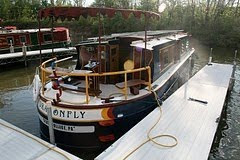The crew of the Dragonfly had been poring over maps and clicking around to websites. The Jewish New Year was approaching; would we find a place to observe the holiday? In small rural towns, synagogues can be thin on the ground.
Luckily, Peoria (the largest town between Chicago and St. Louis) had a congregation we could visit: Anshai Emeth. On the appointed day, Dragonfly tied up at the Peoria town dock. Her crew made an emergency discount department store expedition, to score new khakis for the Cap'n (his lone pair of "dress" pants having long since succumbed to boat grease.) Over holiday dinner--baked salmon with rosemary, roasted potatoes, summer squash with fresh herbs--we lit candles and said the traditional prayer: "May our boat be consecrated, O Lord, by these lights." Then we hailed a taxi.
We enjoyed talking with our taxi driver, whose son had just returned from four years with the Marines in Iraq, and was now quarterbacking the local college football team. Talk about things to be thankful for in the New Year!
Anshai Emeth resembles our home congregation Brit Shalom in State College: A modern multifunctional building dating to the 1960s, housing a congregation whose roots are much older.
A few years ago, the first mate did a series of radio reports about the history of Jewish congregations in rural Pennsylvania. We learned the history of Anshai Emeth in Peoria is quite similar. The first Jewish settlers arrived in the mid-1800s--liberal Jews from western Europe, who were merchants and traders. Later in the century there was a second wave of immigration from eastern Europe--more orthodox Jews from Hungary, Poland and Russia. Christian congregations were supportive and sometimes shared their houses of worship.
We had a very warm welcome from the congregants at Anshai Emeth, and we thoroughly enjoyed the services, led by a student rabbi, a young woman in a demure white blouse and killer red patent leather pumps. The choir, accompanied by two guitars and bongo drums, mixed traditional and innovative themes. A particular high point: the unconventional closing hymn, a bouncy tune that got everyone imitating the sounds of the shofar (the ceremonial ram's horn traditionally sounded on this holiday.)
We don't have a shofar on the boat, but we do have a conch (the shell of a very large, ocean-dwelling snail). The tip of the shell has been filed off, and if you blow very hard, you can make a loud honking sound, very similar to the call of the shofar.
Shofars and conchs were invented for similar purposes: to make a really loud noise that gets people's attention! Back in the mid-1800s, (before modern klaxon horns were invented), canal boat crews used conchs to signal their intentions to other boats.
We put the question to any rabbis who are reading: Is it kosher to salute the New Year with your canal boat conch?






No comments:
Post a Comment